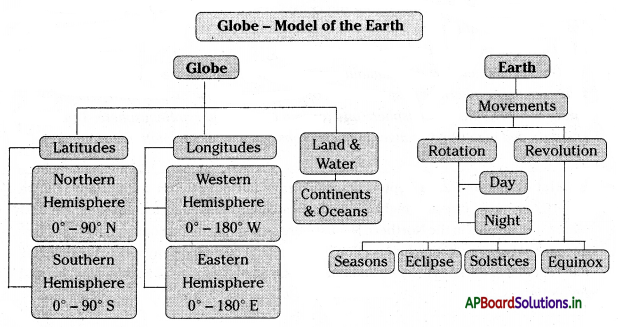Students can go through AP State Board 6th Class Social Studies Notes Chapter 2 Globe – Model of the Earth to understand and remember the concept easily.
AP State Board Syllabus 6th Class Social Studies Notes Chapter 2 Globe – Model of the Earth
→ Globe is a model of the Earth.
→ Latitudes are the imaginary lines that are drawn horizontally on the globe.
→ Longitudes are the imaginary lines that are drawn vertically on the globe.
→ Longitudes are also known as Meridians.
→ Axis is an imaginary straight line that runs through the North and South Pole.
→ 23 1/2 degrees north latitude is called a Tropic of cancer.
→ 23 1/2 degrees south latitude is called as Tropic of Capricorn.
→ 66 1/2 degrees north latitude is called Arctic Circle.
→ 66 1/2 degrees south latitude is called as Antarctic Circle.
→ 90 degrees north latitude is called the North Pole.
→ 90 degrees south latitude is called the South Pole.
→ 0 degrees longitude is known as Greenwich longitude.
→ 180 degrees east and west longitude are known as International Date Line.
→ The half of the Earth that lies north of the equator is called as Northern Hemisphere. The half of the Earth that lies south of the equator is called as Southern Hemisphere.
![]()
→ The half of the Earth that lies east of the prime longitude is called as Eastern Hemisphere.
→ The half of the Earth that lies west of the prime longitude is called as Western Hemisphere.
→ There are two types of Earth movements. They are Earth Rotation, Earth Revolution.
→ The main result of the Earth Rotation is the occurrence of day and night.
→ The main result of the Earth Revolution is the occurrence of seasons.
→ Seasons are the divisions of the year, defined by changes in weather.
→ Solar Eclipse occurs when the Moon passes between the Sun and Earth on one line.
→ Lunar Eclipse occurs when the Earth moves between Sun and Moon on one line.
→ Axis: An imaginary line about which a body rotates.
→ Equator: 0° latitude.
→ Tropic of Cancer: 23 1/2 Northern Latitude
→ Tropic of Capricorn: 23 1/2 Southern Latitude
→ Arctic Circle: 66 1/2 Northern Latitude
→ Antarctic Circle: 66 1/2 Southern Latitude
→ North Pole: 90° Northernmost part of the Earth.
→ South Pole: 90° Southernmost part of the Earth.
→ Meridians: Longitudes connecting North and South poles and shows mid-day
→ Greenwich/Prime meridian : 0° longitude.
→ International Dateline: 1800 east and west longitudes
→ Latitudes: Imaginary lines that run parallel to the equator.
→ Longitudes: Imaginary lines that run between the North pole and South pole.
→ Northern Hemisphere: The half of the earth that lies north of the equator.
→ Southern Hemisphere: The half of the earth that lies south of the equator.
→ Eastern Hemisphere: Half of the earth that lies east of the Prime Meridian.
→ Western Hemisphere: Half of the earth that lies west of the Prime Meridian.
→ Seasons: Seasons are divisions of the year, defined by changes in weather.
![]()
→ Solar Eclipse: Occurs when the Mòon passes between the Sun and Earth on one line.
→ Lunar Eclipse: Occurs when Earth moves between Sun and Moon on one line.

